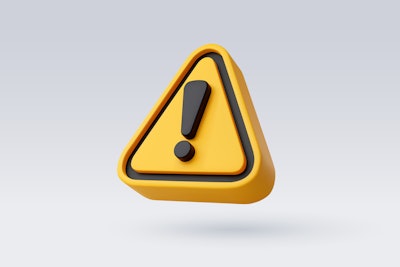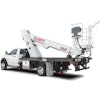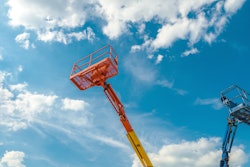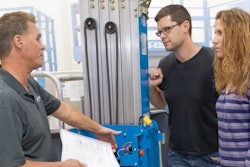
Following its investigation into the cause of a double fatality MCWP accident in the U.K., the U.K. Health and Safety Executive (HSE) issued a National Safety Alert.
The safety alert
The safety alert was titled "Mast Climbing Work Platforms: Failure to detect mechanical failure in drive units leading to uncontrolled fall of platforms."
Distribution of the alert was aimed at the HSE’s identified target audience:
- Construction and all other industry users
- Employers, duty holders and anyone else who has responsibility and/or control directly or indirectly for supply, installation, use, inspection, servicing, maintenance and thorough examination of mast climbing work platforms (MCWPs)
The industry impact
Almost immediately, equipment owners and users throughout the U.K. grounded all MCWPs and asked rental companies and manufacturers to verify the safe operation and compliance of their equipment.
The initial challenge for the industry was that the alert was unexpected, and it caught everyone by surprise. The second issue was that the industry was having difficulty in interpreting exactly what the HSE was saying.
What type of mast climber was identified in the HSE alert? What was the specific issue identified? What modifications were required to ensure compliance?
Additionally, the HSE alert seemed to be saying that mast climbers, which were regarded by manufacturers as compliant to the European standard, En1495:1997+A2:2009, might not be regarded as acceptable to the HSE.
What was certain at this early stage was that the safety alert grounded around 80 percent of the U.K.'s rental fleet, delayed many construction projects, created immediate concern and instability in the industry and raised many legal concerns.
Coordination and leadership
The International Powered Access Federation (IPAF) took a leadership role at this point, coordinating with industry players to assess the national problem in its entirety and reached out to HSE to begin to understand fully what the HSE was saying.
IPAF brought together mast climber industry technical experts from all over the world to analyze the alert language, examine the alert language in the context of the current EN regulation and the language in British Standard BS7981, and then communicated the industry’s questions and requests for clarification as required, subsequently bringing the HSE’s responses back to members for important updates. Those communications were periodic, objective and clear.
The early identification and encapsulation of the problem not only provided a coordinated industry understanding and response, but it also provided an accurate picture for the wider construction industry, effectively managing the potential of the rumor mill.
IPAF achieved a number of important outcomes through this coordination and leadership role:
- Minimize the negative impact of the alert in the market
- Prevent the alert from affecting other regions outside the U.K.
- Coordinate manufacturers to analyze and increase machine safety controls
- Help rental companies and equipment owners get their fleets back up and running as soon as possible
- Learn from the alert, and share that knowledge to raise safety standards in the industry
- Create a stronger position to influence future industry standards and regulations.
- Dealing with safety alerts as an industry
- Product safety alerts can come from a number of sources and can be classified as:
Government/regulator alert (reactive): This is an "industry, external" alert, generated outside of the industry but which affects the industry and in many instances is generated without industry collaboration, and without notice.
Industry organization alert (proactive): This is an "industry, internal" alert, which generally emanates from an analysis of accident statistics, industry safety issues or other industry performance factors. The alert is identified by the industry bodies and is arrived at through a process of consultation with manufacturers, owners and users.
Equipment owner/user alert (proactive): This is usually a "company, internal" alert relating to a design/performance or user issue. The equipment owner/user recognizes the need to inform its customer and user base of the issue and may require elevating the issue to the wider industry.
In all the above cases, the formula to deal with the alert can be based on a number of important steps:
Identify. What exactly is the issue? (For instance, hydraulic cylinder creep is a symptom, but a malfunctioning check valve is the problem.)
Quantify. How many units are involved, in what countries? What action is immediately necessary? What’s the solution and the cost?
Impact. How will the global population be affected? For example, a mass stand down of equipment, legal implications, contract consequential loss liability, etc.
Solution. Based on the identification, quantification and impact, put the best solution into practice.
In the proactive scenarios, the opportunity to craft a consistent and considered message to the market is extremely important. Therefore, outreach becomes a very significant tool to manage the impact, provide a consistent solution and reach as many affected owners and users as possible. It’s also vital in the outreach process to remember that customers will likely see the outreach material and need to be reassured and confident about the solution.
IPAF was vital in the response to the U.K. Mast Climber Safety Alert by the HSE.
Government bodies and/or regulators find it easier to talk to "the industry" than an individual company and, to that end, IPAF was crucial in this regard. It presented to the HSE a nonbiased industry representative with the ability to provide industrywide outreach and impact with integrity and consistency.
Additionally, IPAF’s ability to bring together industry expertise, provide resources to assist and facilitate the process, and its ability to bring industry expertise from all over the world to collaborate on an effective solution was more than significant.
It’s really simple: Safety Alerts are industry problems, best solved by the industry, and IPAF is the representative of the whole powered access industry.




















